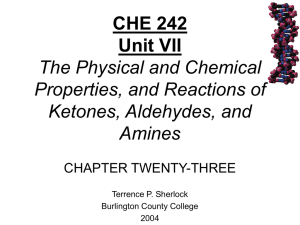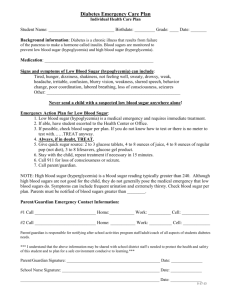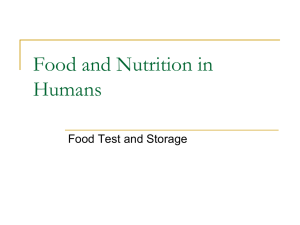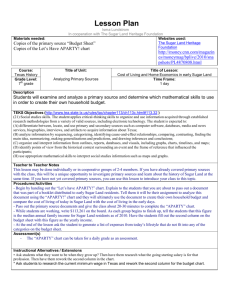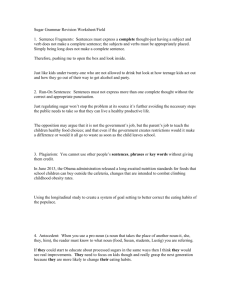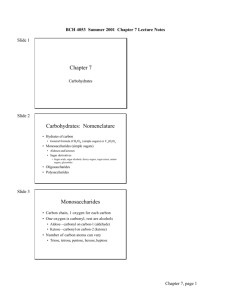Carbohydrates
advertisement
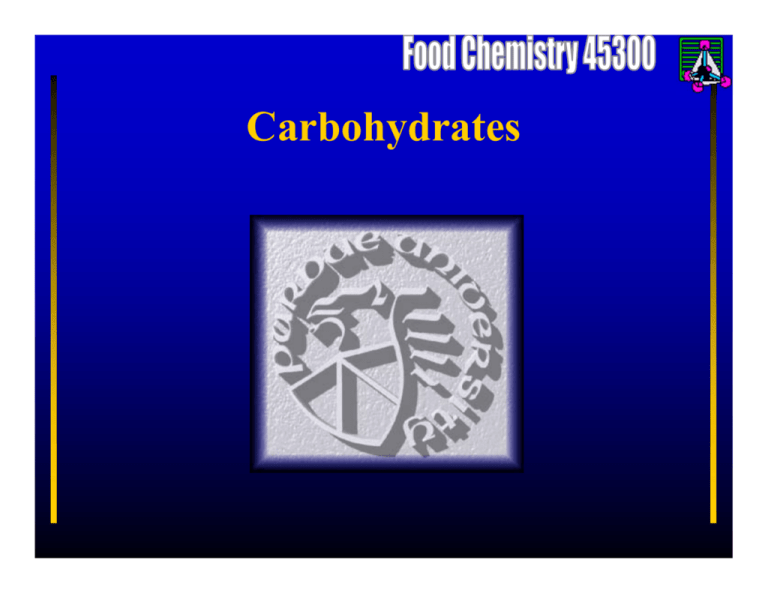
Carbohydrates Real world food nonsense Carbohydrates (sugars) • Source – Many foods including fruits and vegetables – Commercial source of sucrose is sugar cane and sugar beets Functions in foods • Sweetening agents • Texturizer in baked goods • Required for “normal” pectin gel (fruit jelly) formation • Principal ingredient in candy Aldoses and ketoses • Carbohydrates are polyhydroxy aldehydes and ketones OH O H D-glucose HO H H OH H OH 1 O 2 HO H 3 4 OH H OH H OH 5 OH 6 OH D-fructose Classification by functional group No. of Aldehyde carbon atoms 3 Triose Ketone Triulose 4 Tetrose Tetrulose 5 Pentose Pentulose 6 Hexose Hexulose 7 Heptose Heptulose D-glyceraldehyde O H H OH H OH This is a chiral carbon (it is bonded to 4 different groups) Because of the chirality of this molecule we can have two sets of structures, D-glyceraldehyde (shown here) and its mirror image, L-glyceraldehyde. H Emil Fischer, 1852-1919 D- and L-sugars D-glyceraldehyde L-glyceraldehyde D and L sugars are always mirror images! Determination of D or L in other sugars • Draw the Fischer projection with the carbonyl group at the top Determination of D or L in other sugars • Locate the chiral carbon atom farthest from the carbonyl group Determination of D or L in other sugars • If the OH group on this carbon points to the right, it is a D-sugar • If the OH group on this carbon points to the left, it is an L-sugar Rosanoff structures D-glyceraldehyde D- erythrose D-threose Rosanoff structures D-threose D-erythrose D-ribose D-arabinose D-xylose D-lyxose The D-pentoses (Fischer projection) H O H O H OH HO H OH H OH HO H OH H OH H OH D-ribose H H H H O OH HO H H HO H O OH OH OH D-arabinose D-xylose H OH OH D-lyxose Rosanoff structures • In similar fashion one could construct the D-hexoses (see page number 144, Lecture Notes) • Mnemonic for remembering the names of the D-hexoses – “All altruists gladly make gum in gallon tanks” – Allose, altrose, glucose, mannose, gulose, idose, galactose, talose Generating the D-hexoses Isomerization HO CHO OH HO H H OH OH CHO OH OH O OH HO H HO HO HO HO OH OH OH OH OH OH OH OH OH OH OH OH OH OH D-glucose D-fructose Trans-enediol D-mannose Cis-enediol Lobry de Bruyn-Alberda van Ekenstein transformation Isomerization • Enzymatically mediated reaction of this type is used today to produce high fructose corn syrup (HFCS) used in soft drinks • Efforts by the Corn Refiners Association to rename HFCS as “corn sugar” were denied by the FDA on May 31, 2012 HFCS ridiculousity Acetal formation OH H O H H H H H H H H aldehyde H + H3C OH alcohol O H H H H H H H H CH3 hemiacetal But what happens when the alcohol is part of the aldehyde structure to begin with? Ring formation H H HO O OH H H OH H OH OH D-glucose (open chain) CH2OH O OH H H OH H HO H H OH D-glucopyranose (Haworth projection) Ring size--reference compounds O pyran O tetrahydrofuran Ring size O H O H H O H O O O O H O O H O H alpha-D-glucopyranose H O O H H beta-D-fructofuranose Ring representations CH2OH O OH OH HOH2C HO HO HO OH O OH OH beta-D-glucopyranose 4C1 chair conformation of (Haworth projection) beta-D-glucopyranose Ring hydrogens are not shown here for purposes of clarity. Ring structures HOH2C O HO HO OH HO alpha-D-glucopyranose HOH2C O HO HO OH OH beta-D-glucopyranose This is a special type of isomer called ANOMERS Anomeric carbon determination • Find the ring oxygen atom OH H H OH OH H OH HO H OH alpha-D-glucopyranose Anomeric carbon determination • Locate the attached carbon atoms OH H H OH OH H OH HO H OH alpha-D-glucopyranose Anomeric carbon determination • Whichever of these two carbons has another directly attached oxygen is the anomeric carbon OH H H OH OH H OH HO H OH alpha-D-glucopyranose The anomeric carbon atom or anomeric center Reducing sugars • If this attached oxygen is part of an OH (hydroxyl) group, this is a reducing sugar OH H H OH OH H HO OH H OH alpha-D-glucopyranose Non-reducing sugars • If the oxygen atom bears any group other than H (such as alkyl, aryl, etc.), then it is a non-reducing sugar OH H H OH OH H O HO H CH3 OH methyl alpha-D-glucopyranoside Ring equilibriums open chain Image courtesy of Engelsen (newton.foodsci.kvl.dk/engelsen/ poster/mgms_poly.html#Disordered) Carbohydrate classes • Monosaccharides – One sugar ring • Disaccharides – Two sugar rings combined • Oligosaccharides – A few sugar rings combined • Polysaccharides – Many sugar rings combined Monosaccharides OH H HO HO H H H OH HO O H OH alpha-D-glucopyranose O H H OH HO HO OH H beta-D-fructofuranose Disaccharides Images courtesy of MIT Biology Hypertextbook (esg-www.mit. edu:8001/esgbio/lm/sugars/sugar.html) Sucrose (another view) D-fructose D-glucose Invert sugar H+ Acid catalyst Glu-O-Fru Protonation of the glycosidic oxygen weakens this bond. Invert sugar H Glu-O Fru+ O H H Invert sugar H Glu-O Fru O+ H H Invert sugar H Glu-O + Fru O H H+ This 1:1 mixture of glucose Regenerated catalyst and fructose is invert sugar. Oligosaccharides • 3-10 monosaccharide units (an arbitrary number) – Raffinose = D-fructose, D-glucose, Dgalactose – Stachyose – Verbascose Polysaccharides • More than 10 monosaccharide units (usually hundreds or thousands) – Cellulose and plant gums • Structure, texture – Starch (amylose, amylopectin) • Energy storage (plants) – Glycogen • Energy storage (animals) Amylose Alpha-1,4-linkage Image courtesy of Dept. of Biological Science, Western Michigan Univ. (www.wmich.edu/bios150/osmosis.html) Amylopectin Alpha-1,6 Image courtesy of Dept. of Biological Science, Western Michigan Univ. (www.wmich.edu/bios150/osmosis.html) Cellulose Beta-1,4 linkage Image courtesy of MIT Biology Hypertextbook (esg-www.mit. edu:8001/esgbio/lm/sugars/sugar.html) Occurrence of common sugars • Glucose – Most abundant in foods. Also called grape sugar or dextrose. • Fructose – Occurs in many fruits. The major sugar in honey. Also called fruit sugar or levulose. • Galactose – Constitutent of lactose (milk sugar). Reducing and non-reducing sugars Non-reducing Reducing Fehling’s test • 2Cu(OH)2 + Blue solution • RCOOH + RCHO Reducing sugar Cu2O + Red precipitate H2O Control Glucose Fehlings vs Benedicts The Tollen’s test and other reducing sugar oxidations Silver mirror Tollen’s test Fehling’s test

